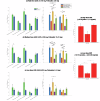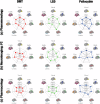Synergistic, multi-level understanding of psychedelics: three systematic reviews and meta-analyses of their pharmacology, neuroimaging and phenomenology
- PMID: 39632810
- PMCID: PMC11618481
- DOI: 10.1038/s41398-024-03187-1
Synergistic, multi-level understanding of psychedelics: three systematic reviews and meta-analyses of their pharmacology, neuroimaging and phenomenology
Abstract
Serotonergic psychedelics induce altered states of consciousness and have shown potential for treating a variety of neuropsychiatric disorders, including depression and addiction. Yet their modes of action are not fully understood. Here, we provide a novel, synergistic understanding of psychedelics arising from systematic reviews and meta-analyses of three hierarchical levels of analysis: (1) subjective experience (phenomenology), (2) neuroimaging and (3) molecular pharmacology. Phenomenologically, medium and high doses of LSD yield significantly higher ratings of visionary restructuralisation than psilocybin on the 5-dimensional Altered States of Consciousness Scale. Our neuroimaging results reveal that, in general, psychedelics significantly strengthen between-network functional connectivity (FC) while significantly diminishing within-network FC. Pharmacologically, LSD induces significantly more inositol phosphate formation at the 5-HT2A receptor than DMT and psilocin, yet there are no significant between-drug differences in the selectivity of psychedelics for the 5-HT2A, 5-HT2C, or D2 receptors, relative to the 5-HT1A receptor. Our meta-analyses link DMT, LSD, and psilocybin to specific neural fingerprints at each level of analysis. The results show a highly non-linear relationship between these fingerprints. Overall, our analysis highlighted the high heterogeneity and risk of bias in the literature. This suggests an urgent need for standardising experimental procedures and analysis techniques, as well as for more research on the emergence between different levels of psychedelic effects.
© 2024. The Author(s).
Conflict of interest statement
Competing interests: The authors declare no competing interests.
Figures







Similar articles
-
Spectral signatures of serotonergic psychedelics and glutamatergic dissociatives.Neuroimage. 2019 Oct 15;200:281-291. doi: 10.1016/j.neuroimage.2019.06.053. Epub 2019 Jun 24. Neuroimage. 2019. PMID: 31247301
-
Serotonergic Psychedelics: Experimental Approaches for Assessing Mechanisms of Action.Handb Exp Pharmacol. 2018;252:227-260. doi: 10.1007/164_2018_107. Handb Exp Pharmacol. 2018. PMID: 29532180 Free PMC article.
-
Serotonergic psychedelics LSD & psilocybin increase the fractal dimension of cortical brain activity in spatial and temporal domains.Neuroimage. 2020 Oct 15;220:117049. doi: 10.1016/j.neuroimage.2020.117049. Epub 2020 Jun 30. Neuroimage. 2020. PMID: 32619708
-
Human behavioral pharmacology of psychedelics.Adv Pharmacol. 2022;93:105-132. doi: 10.1016/bs.apha.2021.10.003. Epub 2021 Nov 11. Adv Pharmacol. 2022. PMID: 35341564 Review.
-
Psilocybin and Other Classic Psychedelics in Depression.Curr Top Behav Neurosci. 2024;66:149-174. doi: 10.1007/7854_2023_451. Curr Top Behav Neurosci. 2024. PMID: 37955822 Review.
Cited by
-
Network control energy reductions under DMT relate to serotonin receptors, signal diversity, and subjective experience.Commun Biol. 2025 Apr 18;8(1):631. doi: 10.1038/s42003-025-08078-9. Commun Biol. 2025. PMID: 40251353 Free PMC article.
-
Integrating Artificial Intelligence and Digital Innovations in Psychedelic and Brain Therapeutics.ACS Med Chem Lett. 2025 Jan 23;16(2):213-215. doi: 10.1021/acsmedchemlett.5c00029. eCollection 2025 Feb 13. ACS Med Chem Lett. 2025. PMID: 39967618
-
Psychiatric Treatments with Short-Duration Psychedelics and AI-Driven Behavioral Monitoring.ACS Med Chem Lett. 2025 Jan 29;16(2):219-221. doi: 10.1021/acsmedchemlett.5c00031. eCollection 2025 Feb 13. ACS Med Chem Lett. 2025. PMID: 39967620
References
-
- Garcia ACM, Maia L.de O. The therapeutic potential of psychedelic substances in Hospice and palliative care. Prog Palliat Care. 2022;30:1–3.
-
- Muttoni S, Ardissino M, John C. Classical psychedelics for the treatment of depression and anxiety: a systematic review. J Affect Disord. 2019;258:11–24. - PubMed
-
- Nutt D, Erritzoe D, Carhart-Harris R. Psychedelic Psychiatry’s Brave New World. Cell. 2020;181:24–8. - PubMed
Publication types
MeSH terms
Substances
Grants and funding
- 210920/Z/18/Z/Wellcome Trust (Wellcome)
- P2ZHP1\161626/Schweizerischer Nationalfonds zur Förderung der Wissenschaftlichen Forschung (Swiss National Science Foundation)
- DNRF117/Danmarks Grundforskningsfond (Danish National Research Foundation)
- WT_/Wellcome Trust/United Kingdom
- SFF2021_CB_MSD_1371024/Oxford University | Balliol College, University of Oxford (Balliol College)

